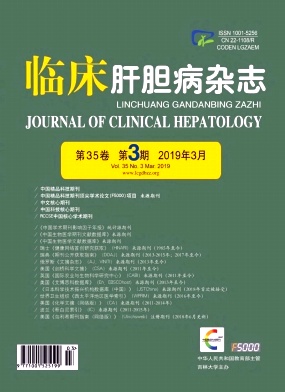|
[1] CHEN W, ZHENG R, ZUO T, et al. National cancer incidenceand mortality in China, 2012[J]. Chin J Cancer Res, 2016, 28 (1) :1-11.
|
|
[2] CHEN W, ZHENG R, BAADE PD, et al. Cancer statistics in Chi-na, 2015[J]. CA Cancer J Clin, 2016, 66 (2) :115-132.
|
|
[3] REN J, ZHOU XN. Development of drug induced liver injury inanti-tumor treatment[J]. Chin J Drug Appl Monit, 2012, 9 (6) :309-313. (in Chinese) 任军, 周心娜.抗肿瘤药物肝损伤研究进展[J].中国药物应用与监测, 2012, 9 (6) :309-313.
|
|
[4] VINCENZI B, ARMENTO G, SPALATO CERUSO M, et al, Drug-induced hepatotoxicity in cancer patients-implication for treat-ment[J]. Expert Opin Drug Saf, 2016, 15 (9) :1219-1238.
|
|
[5] Drug-induced Liver Disease Study Group, Chinese Society ofHepatology, Chinese Medical Association. Guidelines for themanagement of drug-induced liver injury[J]. J Clin Hepatol, 2015, 31 (11) :1752-1769. (in Chinese) 中华医学会肝病学分会药物性肝病学组.药物性肝损伤诊治指南[J].临床肝胆病杂志, 2015, 31 (11) :1752-1769.
|
|
[6] CHEN CW. Research advances in drug-induced liver injuryand existing problems in China[J]. J Clin Hepatol, 2018, 34 (6) :1147-1151. (in Chinese) 陈成伟.药物性肝损伤的研究进展及我国存在的问题[J].临床肝胆病杂志, 2018, 34 (6) :1147-1151.
|
|
[7] SHEN T, HUANG X, WANG YY, et al. Current status of epide-miological study on drug-induced liver injury in China[J]. JClin Hepatol, 2018, 34 (6) :1152-1155. (in Chinese) 沈弢, 黄昕, 王誉雅, 等.我国药物性肝损伤流行病学研究现状[J].临床肝胆病杂志, 2018, 34 (6) :1152-1155.
|
|
[8] YUAN Y, LI J, LAN L, et al. Analysis of clinical characteristicsamong 245 cases of patients with drug-induced liver damage[J]. Chronic Pathematology J, 2015, 16 (2) :170-172. (inChinese) 袁媛, 李健, 兰玲, 等. 245例药物性肝损伤病例的临床流行病学特征描述[J].慢性病学杂志, 2015, 16 (2) :170-172.
|
|
[9] ZHU CW, WANG HN, YUAN JL, et al. Clinical features of drug-induced liver injury:An analysis of 445 cases[J]. J Clin Hepatol, 2018, 34 (2) :354-358. (in Chinese) 朱春雾, 王海南, 袁继丽, 等. 445例药物性肝损伤的临床分析[J].临床肝胆病杂志, 2018, 34 (2) :354-358.
|
|
[10] THATISHETTY AV, AGRESTI N, O'BRIEN CB. Chemotherapy-induced hepatotoxicity[J]. Clin Liver Dis, 2013, 17 (4) :671-686.
|
|
[11] BAHIRWANI R, REDDY KR. Drug-induced liver injury due tocancer chemotherapeutic agents[J]. Semin Liver Dis, 2014, 34 (2) :162-171.
|
|
[12] LEISE MD, POTERUCHA JJ, TALWALKAR JA. Drug-inducedliver injury[J]. Mayo Clin Proc, 2014, 89 (1) :95-106.
|
|
[13] YAN SY, FAN JG. Effect of antineoplastic drugs on liver andtheir application in patients with liver diseases[J]. World ClinDrugs, 2011, 32 (9) :513-517. (in Chinese) 颜士岩, 范建高.抗肿瘤药物对肝脏的影响及其在肝病患者中的应用[J].世界临床药物, 2011, 32 (9) :513-517.
|
|
[14] HU XY, SUN J, PENG J. New considerations in antiviral thera-py for special populations with chronic hepatitis B[J]. J ClinHepatol, 2016, 32 (11) :2054-2057. (in Chinese) 胡晓云, 孙剑, 彭劼.乙型肝炎特殊人群抗病毒治疗的新认识[J].临床肝胆病杂志, 2016, 32 (11) :2054-2057.
|
|
[15] KIM E, YUNE S, HA JM, et al. Hepatitis B virus reactivation dur-ing anticancer chemotherapy in patients with past hepatitis B virusinfection[J]. Hepatogastroenterology, 2014, 61 (134) :1704-1711.
|
|
[16] SARIN SK, KUMAR M, LAU GK, et al. Asian-Pacific clinicalpractice guidelines on the management of hepatitis B:A 2015update[J]. Hepatol Int, 2016, 10 (1) :1-98.
|
|
[17] WU SX, XU HY, HUANG HC, et al. Clinical analysis of liver in-jury and hepatitis B virus reactivation after chemotherapy inHBsAg-positive patients with malignant tumors[J]. J ClinHepatol, 2016, 32 (1) :110-113. (in Chinese) 吴盛喜, 许鸿鹞, 黄河澄, 等. HBsAg阳性恶性肿瘤患者化疗后肝损伤及HBV再激活的临床分析[J].临床肝胆病杂志, 2016, 32 (1) :110-113.
|
|
[18] XU L, TU Z, XU G, et al. Epirubicin directly promotes hepati-tis B virus (HBV) replication in stable HBV-expressing celllines:A novel mechanism of HBV reactivation following anti-cancer chemotherapy[J]. Mol Med Rep, 2014, 9 (4) :1345-1350.
|
|
[19] SANAGAWA A, HOTTA Y, KATAOKA T, et al. Hepatitis B in-fection reported with cancer chemotherapy:Analyzing the USFDA adverse event reporting system[J]. Cancer Med, 2018, 7 (6) :2269-2279.
|
|
[20] YANG LH, LIU R, ZENG QY, et al. Association of methyle-netetrahydrofolate reductase gene polymorphism in childrenwith acute lymphoblastic leukemia and adverse reaction ofhigh dose methotrexate[J]. J Appl Clin Pediatr, 2012, 27 (6) :440-442. (in Chinese) 杨丽华, 刘茹, 曾其毅, 等.急性淋巴细胞白血病患儿亚甲基四氢叶酸还原酶基因多态性与大剂量甲氨蝶呤不良反应的相关性[J].实用儿科临床杂志, 2012, 27 (6) :440-442.
|
|
[21] SCRIPTURE CD, FIGG WD. Drug interactions in cancer thera-py[J]. Nat Rev Cancer, 2006, 6 (7) :546-558.
|
|
[22] CAMPEN CJ, VOGEL WH, SHAH PJ. Managing drug interac-tions in cancer therapy:A guide for the advanced practitioner[J]. J Adv Pract Oncol, 2017, 8 (6) :609-620.
|
|
[23] TEO YL, HO HK, CHAN A. Formation of reactive metabolitesand management of tyrosine kinase inhibitor-induced hepato-toxicity:A literature review[J]. Expert Opin Drug Metab Toxi-col, 2015, 11 (2) :231-242.
|
|
[24] LOU XE, CHEN M, YANG B. Research progress in toxicologyof molecular targeted anticancer drugs[J]. J Zhejiang Univ:Med Sci, 2015, 44 (5) :473-478. (in Chinese) 娄小娥, 陈敏, 杨波.分子靶向抗肿瘤药物的毒性研究进展[J].浙江大学学报:医学版, 2015, 44 (5) :473-478.
|
|
[25] PAECH F, BOUITBIR J, KRHENBHL S. Hepatocellular tox-icity associated with tyrosine kinase inhibitors:Mitochondrialdamage and inhibition of glycolysis[J]. Front Pharmacol, 2017, 8:367.
|
|
[26] SHAH RR, MORGANROTH J, SHAH DR. Hepatotoxicity of tyro-sine kinase inhibitors:Clinical and regulatory perspectives[J].Drug Saf, 2013, 36 (7) :491-503.
|
|
[27] Chinese Society of Infectious Diseases, Chinese Medical As-sociation, Expert Committee for Prevention and Managementof Liver Inflammation. Prevention and management of liver in-flammation:An expert consensus in China[J]. Chin J Clin In-fect Dis, 2014, 7 (1) :4-12. (in Chinese) 中华医学会感染病学分会, 肝脏炎症及其防治专家共识专家委员会.肝脏炎症及其防治专家共识[J].中华临床感染病杂志, 2014, 7 (1) :4-12.
|
|
[28] SUN YJ, QI WX, YAO Y. Prevention and treatment of glutathi-one in chemotherapy-induced liver injury[J]. China Cancer, 2015, 24 (1) :57-63. (in Chinese) 孙元珏, 祁伟祥, 姚阳.还原型谷胱甘肽与肿瘤化疗相关性肝损伤的防治[J].中国肿瘤, 2015, 24 (1) :57-63.
|







 DownLoad:
DownLoad: